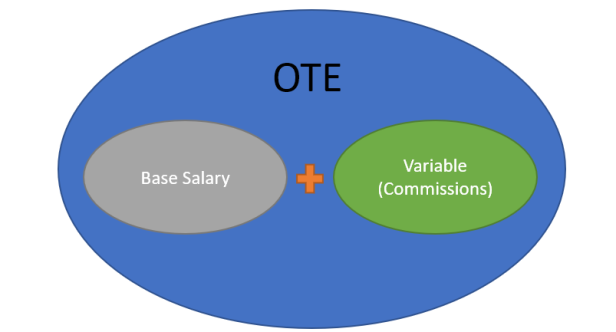What is OTE in Sales
OTE stands for “On-Target Earnings” in sales. It represents the total compensation a salesperson can expect to earn if they meet or exceed their sales targets and goals. OTE typically includes a base salary along with commissions, bonuses, and other incentives tied to performance. It provides a clear benchmark for sales professionals to strive towards, motivating them to achieve their objectives and maximize their earnings potential.
OTE: Definition and Components
What does OTE stand for? OTE refers to the total compensation a salesperson can expect to earn if they meet their sales targets and performance expectations. It typically includes a base salary along with additional incentives such as commissions, bonuses, and other performance-based rewards. Also, read about What is Economy Value
Why OTE is Important in Sales?
OTE plays a pivotal role in the sales landscape for several reasons. Firstly, it serves as a powerful motivator for sales professionals, driving them to achieve and exceed their targets. Secondly, OTE helps in setting clear and measurable performance expectations, aligning the objectives of the sales team with the overall goals of the organization.
Calculating OTE
The formula for calculating OTE is relatively straightforward. It involves summing up the base salary and any additional incentives or bonuses that the salesperson is eligible for based on their performance. However, there are various considerations and variables to take into account, such as sales quotas, commission rates, and performance thresholds.
OTE vs. Base Salary
It’s essential to differentiate between OTE and base salary. While the base salary forms a fixed component of the compensation package, OTE includes both fixed and variable components, with the variable portion contingent upon meeting or exceeding sales targets. The OTE structure offers both advantages, such as incentivizing high performance, and challenges, such as managing expectations and uncertainties regarding earnings. Discover more about What is the Classification of Business

Common OTE Structures
OTE structures can vary significantly depending on the industry, company policies, and individual preferences. Some common OTE structures include commission-based OTE, where sales professionals earn a percentage of the revenue generated from their sales, quota-based OTE, where incentives are tied to achieving predetermined sales targets, and hybrid structures that combine elements of both.
Impact of OTE on Sales Performance
The implementation of OTE can have a profound impact on sales performance. By providing a clear framework for earning potential, OTE incentivizes sales professionals to strive for excellence and consistently deliver results. Moreover, OTE helps in driving sales targets and aligning individual efforts with organizational objectives, thereby enhancing overall productivity and profitability.
Challenges with OTE
Despite its benefits, OTE is not without its challenges. One common issue is the setting of unrealistic targets, which can lead to frustration and demotivation among sales teams. Additionally, managing expectations regarding earnings can be challenging, particularly in industries with fluctuating demand or market conditions.
Strategies for Effective OTE Implementation
To overcome the challenges associated with OTE, organizations can adopt several strategies for effective implementation. Transparent communication regarding OTE structures, performance expectations, and earning potential is paramount. Regular performance monitoring and feedback mechanisms help in identifying and addressing any issues promptly, ensuring a fair and motivating environment for sales professionals.

OTE in Different Industries
The application of OTE can vary significantly across different industries and sectors. While certain industries may rely heavily on commission-based OTE structures, others may prefer quota-based models or hybrid approaches. Understanding the nuances of OTE in specific industries is essential for designing effective compensation packages and attracting top talent.
Legal and Ethical Considerations
When implementing OTE structures, organizations must ensure compliance with relevant labor laws and regulations. Additionally, ethical considerations surrounding fairness, transparency, and equality should be taken into account. Unethical practices such as setting unattainable targets or withholding commissions unfairly can have detrimental effects on employee morale and organizational reputation.
Future Trends in OTE
As the sales landscape continues to evolve, so do practices related to OTE. Emerging trends such as the use of advanced analytics and AI-driven tools for performance tracking and incentive management are reshaping the way OTE is structured and managed. Additionally, the growing emphasis on employee well-being and work-life balance is prompting organizations to reevaluate their OTE strategies and prioritize fairness and equity.

Case Studies: Successful OTE Implementation
Real-world examples of successful OTE implementation can provide valuable insights into best practices and strategies. By examining case studies from various industries and companies, organizations can learn from both successes and failures and tailor their OTE approaches to suit their unique requirements and objectives.
Conclusion
In conclusion, OTE plays a crucial role in the sales domain, serving as a powerful motivator and performance management tool. By understanding the definition, components, and implications of OTE, organizations can design effective compensation packages that drive sales performance and align with their overall business goals. However, it’s essential to navigate the challenges associated with OTE carefully and adopt strategies that promote fairness, transparency, and employee engagement.
FAQs
What does OTE stand for?
OTE stands for On-Target Earnings, which refers to the total compensation a salesperson can expect to earn if they meet their sales targets and performance expectations.
How is OTE calculated?
OTE is typically calculated by summing up the base salary and any additional incentives such as commissions, bonuses, and other performance-based rewards.
What are some common OTE structures?
Common OTE structures include commission-based OTE, quota-based OTE, and hybrid structures that combine elements of both.
What are the benefits of OTE in sales?
OTE incentivizes sales professionals to achieve and exceed their targets, aligns individual efforts with organizational objectives, and drives sales performance and productivity.
How can organizations overcome challenges with OTE implementation?
Organizations can overcome challenges with OTE implementation by adopting transparent communication, regular performance monitoring, and feedback mechanisms, and ensuring compliance with legal and ethical standards.







